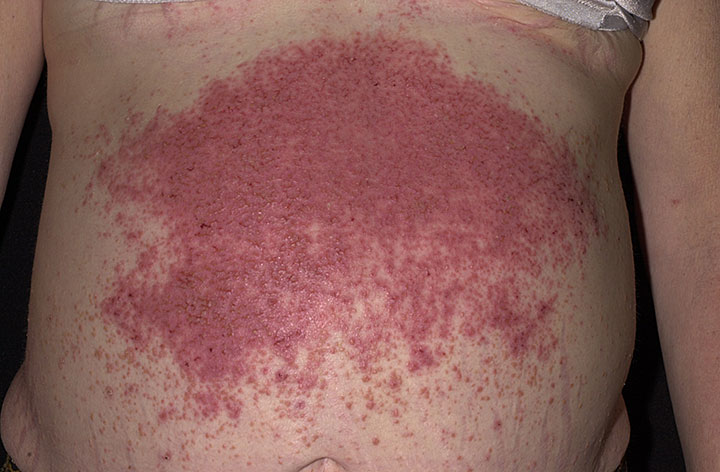Dermatitis Herpetiformis: Symptoms, Causes & Treatment
What are the symptoms of dermatitis herpetiformis?
Dermatitis herpetiformis (DH) is a skin condition characterized by intensely itchy, chronic, and blistering skin lesions. The symptoms of dermatitis herpetiformis may include:
- Itchy skin: The hallmark symptom of DH is intense itching, which can be relentless and interfere with daily activities.
- Skin lesions: DH typically presents as clusters of small, red bumps or blisters that are filled with clear fluid. These lesions are usually symmetrically distributed and commonly appear on the elbows, knees, buttocks, lower back, and scalp.
- Burning sensation: Some people with DH may experience a burning sensation in the affected areas.
- Scratching-induced skin damage: Due to the intense itching, scratching the lesions can lead to skin damage, including excoriation (skin abrasions), scarring, and changes in skin pigmentation.
- Grouped vesicles or papules: The lesions of DH are often grouped or clustered together, and they may be fluid-filled (vesicles) or solid (papules).
- Symmetrical distribution: DH lesions tend to appear on both sides of the body in a symmetrical pattern.
- Chronic course: DH is a chronic condition that tends to wax and wane over time, with periods of flare-ups and remission.
- Association with celiac disease: DH is strongly associated with celiac disease, a digestive condition characterized by an autoimmune response to gluten, a protein found in wheat, barley, and rye.
If you suspect you have dermatitis herpetiformis or are experiencing symptoms similar to those described above, it is important to see a dermatologist or healthcare provider for a proper diagnosis and appropriate treatment.
What are the causes of dermatitis herpetiformis?
Dermatitis herpetiformis (DH) is an autoimmune skin disorder that is strongly associated with celiac disease. The exact cause of DH is not fully understood, but it is believed to involve an abnormal immune response to gluten, a protein found in wheat and other grains.
In individuals with DH who are sensitive to gluten, the ingestion of gluten triggers an immune reaction in the body. This immune response leads to the production of antibodies called immunoglobulin A (IgA) antibodies, which then accumulate in the small blood vessels of the skin. The presence of these IgA antibodies in the skin causes inflammation and the characteristic skin lesions seen in DH.
It is important to note that not everyone with celiac disease will develop DH, and not everyone with DH will have digestive symptoms of celiac disease. However, the two conditions are closely related, and individuals with DH are at an increased risk of having or developing celiac disease.
In addition to gluten sensitivity, genetic factors are also believed to play a role in the development of DH. Certain genetic markers, such as the HLA-DQ2 and HLA-DQ8 genes, are more common in individuals with DH and celiac disease.
Overall, the development of DH is thought to result from a complex interplay of genetic, immunological, and environmental factors, with gluten sensitivity being a key trigger in susceptible individuals.
What is the treatment for dermatitis herpetiformis?
The primary treatment for dermatitis herpetiformis (DH) is a strict gluten-free diet. This is because DH is closely associated with celiac disease, and both conditions are triggered by gluten consumption. Removing gluten from your diet can help reduce or eliminate the skin symptoms of DH and prevent further damage to the intestines in those with celiac disease.
In addition to a gluten-free diet, medications may be prescribed to manage the symptoms of DH. These may include:
- Dapsone: This medication is commonly used to treat DH and is effective in relieving itching and reducing the skin lesions. However, it may cause side effects such as anemia and liver problems, so it should be used under medical supervision.
- Topical corticosteroids: Creams or ointments containing corticosteroids can help reduce inflammation and itching in the affected areas of the skin.
- Antihistamines: These medications can help relieve itching and reduce the allergic response that contributes to the skin lesions.
- Sulfapyridine: This antibiotic medication is sometimes used in combination with dapsone to treat DH.
It is important to work closely with a healthcare provider, such as a dermatologist or gastroenterologist, to develop a treatment plan that is tailored to your individual needs. They can help monitor your condition and adjust your treatment as needed to manage your symptoms effectively.




